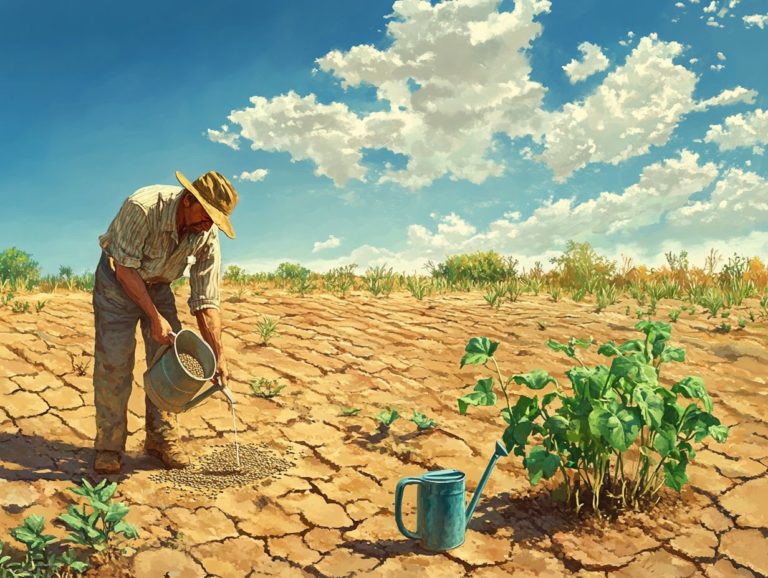How to Incorporate Rainwater Harvesting
Rainwater harvesting is more than just an eco-friendly trend. It s a practical way to manage water resources in a changing climate and helps conserve vital water.
This practice provides numerous advantages, not only for the environment but also for your finances. It offers a variety of systems tailored to your needs.
Explore straightforward ways to integrate rainwater harvesting into your home. Discover the diverse uses for collected rainwater, such as agricultural applications, and keep key factors in mind.
Harness the power of this natural resource to maximize its benefits, ensuring you have a reliable water supply in times of need.
Contents
- Key Takeaways:
- What Is Rainwater Harvesting and Why It Matters?
- Benefits of Rainwater Harvesting
- Types of Rainwater Harvesting Systems
- How to Incorporate Rainwater Harvesting in Your Home
- Uses for Harvested Rainwater
- Considerations and Potential Challenges
- Frequently Asked Questions
- What is rainwater harvesting?
- How can I incorporate rainwater harvesting into my home?
- What are the benefits of incorporating rainwater harvesting?
- Do I need any special equipment to incorporate rainwater harvesting?
- Are there any regulations or restrictions for incorporating rainwater harvesting?
- How do I maintain a rainwater harvesting system?
Key Takeaways:

- Rainwater harvesting is the process of collecting and storing rainwater for future use. It provides environmental and cost-saving benefits.
- There are two main types of rainwater harvesting systems: above-ground and below-ground. Each has its own installation and maintenance tips to consider.
- Harvested rainwater can be used for various purposes, including irrigation, flushing toilets, and even drinking water if properly treated. However, consider local regulations and potential environmental impacts before incorporating it into your home.
What Is Rainwater Harvesting and Why It Matters?
Rainwater harvesting is a sustainable practice that allows you to collect and store rainwater from roofs, driveways, and paved areas. This approach enhances effective water management and plays a crucial role in water conservation, especially in regions facing water scarcity due to the climate crisis.
By using systems like rain barrels, cisterns, and filtration units, you can secure a dependable source of harvested rainwater for your household or urban farm. This reduces reliance on traditional water sources and promotes greater self-sufficiency.
Definition and Purpose
The purpose of rainwater harvesting is to capture and store rainwater for various uses, including drinking and agricultural applications. This involves collecting rain from roofs and other surfaces and channeling it into storage tanks for later use. By enhancing your water supply, rainwater harvesting addresses water scarcity issues, ensuring a reliable source for irrigation and other essential purposes.
It s not just about collection; this method also significantly improves water quality by filtering out pollutants before they reach your storage. Integrating greywater systems enables the effective reuse of water from baths, sinks, and laundry for various household chores, promoting sustainability in your daily life.
For instance, many farmers have successfully adopted rainwater harvesting techniques to irrigate their crops, leading to improved yields while conserving groundwater resources. This shows just how beneficial rainwater harvesting can be for everyone.
Benefits of Rainwater Harvesting
Rainwater harvesting presents a wealth of advantages. It enhances environmental sustainability while delivering significant cost savings for households and communities.
Environmental and Cost Savings
Adopting rainwater harvesting systems can lead to significant cost savings, particularly in regions where water scarcity drives up utility rates. These systems also positively impact the environment by lowering urban heat levels, an essential factor in densely populated areas.
By collecting rainwater, you help mitigate the heat island effect, creating cooler temperatures in your surroundings. Implementing these systems enhances biodiversity by providing habitats for various species and improves overall water quality by filtering out pollutants before they reach larger bodies of water.
Imagine urban farms flourishing with a consistent supply of rainwater, ensuring sustainable food production. This also serves as a reliable emergency water source during droughts, reinforcing community resilience through effective water management.
Types of Rainwater Harvesting Systems

Rainwater harvesting systems fall into two main categories: above-ground and below-ground systems. Each option presents distinct advantages for efficient water management, allowing you to choose the best fit for your needs.
Above-Ground vs. Below-Ground Systems
Above-ground systems, like rain barrels, are easy to install and maintain. Below-ground options, such as cisterns, involve complex installation and higher costs.
This simplicity is why many homeowners prefer above-ground solutions for capturing and utilizing rainwater without extensive excavation or plumbing work. These systems adapt to various landscapes and provide immediate visual cues on water levels, making it easy to monitor storage.
On the other hand, below-ground systems may have larger capacities and are ideal for extensive water management projects, effectively minimizing surface disruption. However, the initial investment and potential maintenance challenges might give you pause.
In urban gardens, rain barrels often play a crucial role in irrigation. Below-ground systems are key players in larger agricultural setups that require significant water reserves for sustainable practices.
How to Incorporate Rainwater Harvesting in Your Home
Incorporating rainwater harvesting into your home is straightforward, achievable through methods like installing rain barrels, cisterns, and rain gardens. For more details on how to effectively implement these practices, check out techniques for capturing rainwater efficiently. This boosts your landscape design and makes a positive environmental impact.
Installation and Maintenance Tips
Proper installation and maintenance of rainwater harvesting systems are essential for ensuring optimal performance and water quality. Both require an initial investment and ongoing attention.
As a homeowner eager to embrace this eco-friendly solution, understanding the installation process is vital. Costs can vary significantly based on the system s size, complexity, and local regulations. It s wise to consult knowledgeable professionals for detailed estimates and guidance through the permitting process.
Integrating essential monitoring systems is crucial, allowing you to track water levels and quality while promptly alerting you to potential issues. Implementing filtration methods, such as sediment filters and UV sterilizers, is key to preventing contaminants and ensuring the quality of your harvested rainwater.
Regular maintenance checks including cleaning gutters and inspecting system components are necessary to extend the lifespan and efficiency of your system. This will keep it in peak condition for years to come.
Uses for Harvested Rainwater
Harvested rainwater offers many uses, from enhancing your irrigation systems for lush landscaping to supporting household chores and even nourishing livestock. It s a versatile resource that brings both practicality and sustainability to your daily life.
Ways to Utilize Collected Water

You can utilize collected rainwater in several practical ways. Direct it towards irrigation systems, use it for household chores, or provide drinking water for livestock through efficient water reuse.
Consider implementing rainwater harvesting through innovative practices, like installing rain barrels. These barrels capture runoff from roofs, letting you use the stored water for landscape gardening or flushing toilets.
For agricultural applications, employing integrated grey water systems can yield substantial benefits. These systems recycle water from sinks, showers, and laundry, nourishing crops while significantly reducing overall water consumption.
By skillfully combining these techniques, you can bolster your water security, achieve notable cost savings, and promote environmental sustainability in both residential and agricultural settings. Start capturing rainwater today for a greener tomorrow!
Considerations and Potential Challenges
Before you implement a rainwater harvesting system, consider a few key factors. Local regulations can dictate what s permissible in your area, so it is essential to familiarize yourself with those guidelines.
Additionally, think about the potential environmental impacts of your system how will it affect your surroundings? Lastly, do not overlook the initial installation costs; understanding these will help you make an informed decision moving forward.
Factors to Keep in Mind Before Implementing
When you re planning to implement a rainwater harvesting system, it s crucial to take local regulations, environmental impacts, and installation costs into account for effective sustainable water management, ensuring compliance with municipal guidelines.
By understanding these regulations, you ensure compliance with municipal guidelines, which can vary greatly depending on your region. Beyond legal adherence, evaluating potential environmental impacts allows you to pinpoint any ecological benefits or challenges that may come from collecting runoff.
Installation costs can vary based on the complexity of the system and the materials you choose, making precise budgeting essential. Incorporating monitoring systems provides significant advantages in tracking performance and maintaining efficiency. These systems not only aid in regulatory compliance but also help you manage water wisely.
Frequently Asked Questions
What is rainwater harvesting?
Rainwater harvesting is the process of collecting, storing, and using rainwater for various purposes such as irrigation, household chores, and even drinking.
How can I incorporate rainwater harvesting into my home?

There are several ways to incorporate rainwater harvesting into your home, including installing a rain barrel, building a rain garden, or using a cistern system (a large tank for storing rainwater).
What are the benefits of incorporating rainwater harvesting?
Incorporating rainwater harvesting can help conserve water, reduce water bills, and provide a sustainable source of water for gardens and other household needs.
Do I need any special equipment to incorporate rainwater harvesting?
The equipment needed will depend on the type of rainwater harvesting system you choose. Basic equipment may include a rain barrel, a gutter system, and a pump for cistern systems.
Are there any regulations or restrictions for incorporating rainwater harvesting?
Make sure to check with your local government for any rules in your area! Regulations and restrictions for rainwater harvesting vary by location.
How do I maintain a rainwater harvesting system?
Keep your system running smoothly by regularly cleaning gutters and checking for leaks! Regular maintenance may also involve treating the collected rainwater for drinking purposes.





